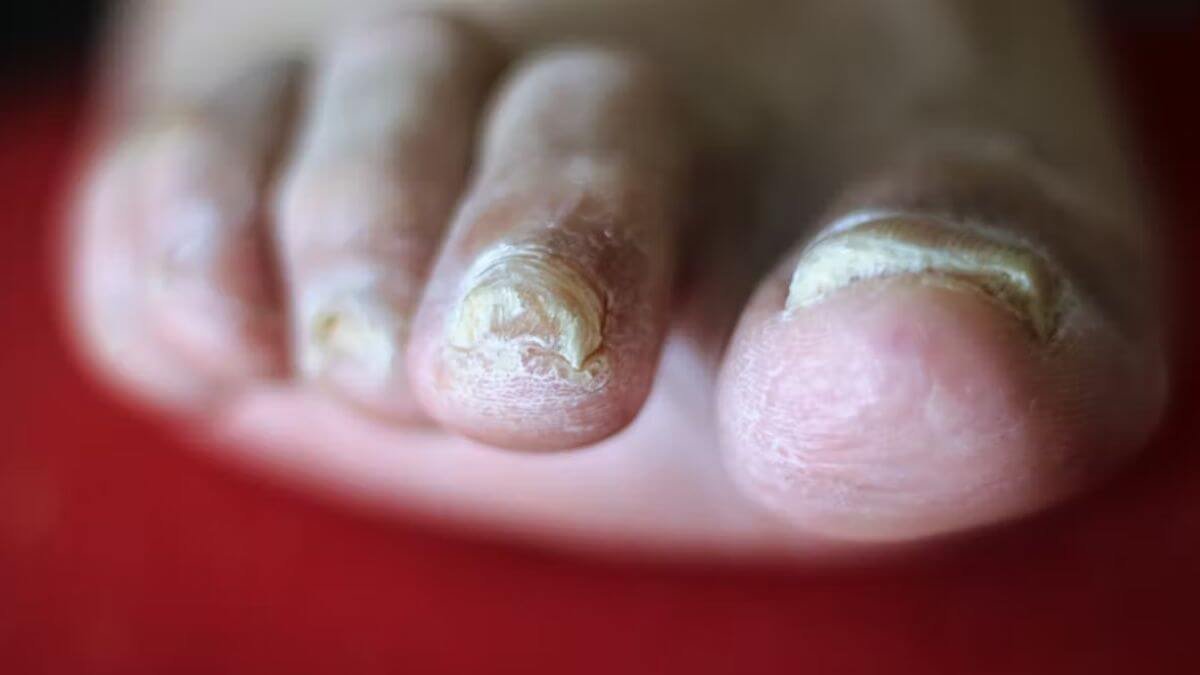Fungal infections seen in fingernails or toenails are commonly referred to as nail infections. The scientific name for fungal nail infection is onychomycosis.
Your fingernails or toenails can become discolored due to fungal nail infections. When the condition gets severe, the nails may break and the infection can spread to other nails.
As the nail infection progresses the nails will get thicker and crumble. Fungal infections are commonly seen in the toenails rather than fingernails.
Symptoms Of Nail Infections
Fungal nail infections can be identified easily by monitoring the symptoms. Some of them are :

- Discoloration
- Crumbled nails
- Foul odor
- Thickened nails
- Pain etc
What Causes Nail Fungus?
The major reason behind nail infections is the different types of fungi that are present in our surroundings.
These fungi can enter your nail through any minute openings present in your skin and can cause infections very easily.
Worsened nail infections can be painful and can lead to other diseases. Some of the major factors that cause nail infections include:
- Injury on the nails
Nail infections can be caused due to previous injuries to the nails or skin. Germs can enter the nails through this injured area and result in infections.
- Poor hygiene
Poor hygiene habits can greatly increase the risk of getting nail infections. Dirty nails can get infections pretty easily.
- Hereditary factors
A positive family history of nail infections can also act as a reason for infections to cause.
Types Of Nail Infections
Nail infections are of different types.
- Candidal onychomycosis
Candidal onychomycosis is commonly affected by fingernails and is caused by yeast.
This type of infection can be seen mostly in people with different medical conditions such as diabetes Mellitus, HIV infection, etc. The infected nails may peel off.
- White superficial onychomycosis
Nails are likely to get powdery and crumbled by white superficial onychomycosis. The surface layers of the nails are affected by this fungus.
- Proximal subungual onychomycosis
Proximal subungual onychomycosis is commonly noticed by the appearance of the white spots on the nails which will spread as the nail grows.
4. lateral subungual onychomycosis
Lateral or distal subungual onychomycosis can affect both
toenails and fingernails. This infection is caused by dermatophytes, and distal subungual onychomycosis is the most commonly seen fungal nail infection.
Risk Factors Of Nail Infection
Nail fungal infections can be triggered by various reasons including your lifestyle habits and personal hygiene.

- Having a weak immune system can make you more vulnerable to these nail infections. Eating foods and taking medication that provides immunity can help you to build up immunity power.
- A low blood circulation process can increase the chances of getting nail infections. Avoid wearing tight socks or shoes for better blood circulation.
- If you had an injury or any kind of surgery the possibility of getting nail infections is high. Germs can enter through your wounds and cause infections. Keep the injured area clean to avoid such diseases.
- A poor hygiene habit makes the chances of getting an infection way too high. Cleaning your nails and toes and trimming them should be done frequently without fail.
- Make sure the parlor you go to for a pedicure and manicure sterilizes the tools before use.
- Constant use of artificial nails and nail enamels can also cause nail infections.
Treatment For Nail Infections
Nail infections are treatable and curable. There are a few home remedies that can be done for fungal nail infections. If the nail infection persists for a longer period of time, go see a doctor and take the necessary medications.
✔️ Using vinegar
Using or applying vinegar on the affected toenail or fingernail can reduce the infection.
✔️ Changes in diet
Make changes in your diet and increase the consumption of food that is rich in giving immunity.
✔️ Garlic
The antifungal function of garlic can be used to treat nail infections. Garlic paste can be applied to the affected area and this has proven to work as a perfect treatment.
✔️ Tea tree oil
Tea tree oil can be applied to the infected nail regularly to see results. It has antifungal and antimicrobial properties which can be useful This ingredient is found in kerassentials.
✔️ Taking medication
Apart from home remedies, taking proper medication for nail infections with a doctor’s consultation can make your nail infection better. In case of severe pain, it is appropriate to take medical assistance.
Outlook
Preventing diseases is always better than curing them. You can prevent nail infections by taking proper precautions.
A few simple changes in your habits can make you immune to several diseases.
Try to maintain good hygiene and choose a good lifestyle for a healthy future.
